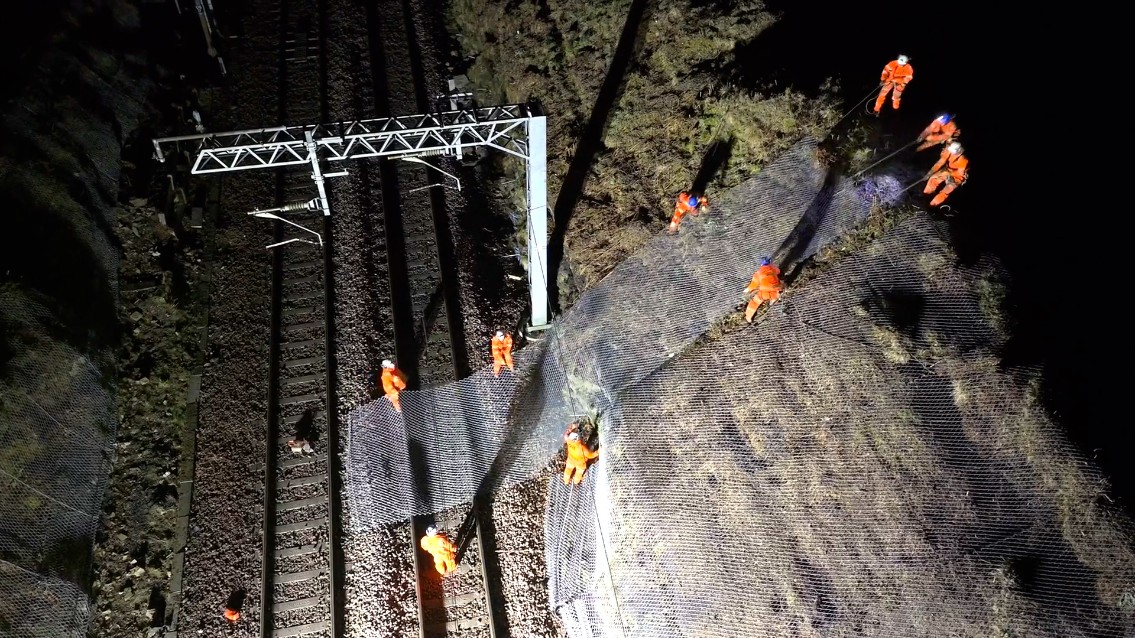Friday 8 Mar 2024
Multi-million-pound flood resilience project at Croy complete
- Region & Route:
- Scotland’s Railway: Scotland
A £3.5m programme to improve the resilience of the railway between Croy and Dullatur in extreme weather has been delivered successfully.
Over the last 12 months, Network Rail and QTS have carried out work to improve drainage and prevent landslips on the Edinburgh – Glasgow main line (on behalf of Scotland’s Railway).
This line carries tens of thousands of people every day between the two cities at speeds of up to 100mph but has faced speed restrictions during periods of heavy or prolonged rain due to the increased risk of landslips.
Our railway engineers have cleared vegetation, upgraded drainage systems, and installed high-strength mesh, soil nails and rock bolts to help prevent wash-outs and rock falls and reduce the need to slow trains down.
Sean Gallacher, regional asset manager - geotech, Network Rail, said: “The Edinburgh to Glasgow line was first built in 1842 by the Victorians, whose approach to ground engineering was different to the way it is now.
“As a result of the steep earthworks they built and the fact the assets are ageing, we have had to slow trains down to keep everyone safe during periods of extreme rainfall, where there’s a higher risk of landslips.
“This crucial project will reduce the need to slow down trains during heavy rain, meaning more journeys are completed on time.
“It’s all part of our commitment to running a safe and reliable railway for our passengers.”
Cuttings are where the tracks are cut deep into hillsides, while embankments were built to carry the tracks across valleys – reducing the gradients trains face on their journeys.
Brian Connolly, project manager – capital delivery, Network Rail, said: “Our work at Croy has involved installing rock netting, maintenance of around 1km of drainage and installation of over 500 soil nails to ensure the stability of the high slopes and prevent rocks and earth from falling onto the line.
“Alongside this work, more than 5000 square meters of vegetation has been cut back through the cutting to allow inspection and installation of the 6500 square meters of rock netting.”
Chris Blair, contract manager from QTS, said: “Much of the work at Croy was carried out by our IRATA (rope trained) operatives. We also used QTS skid rigs* – all of this enabled us to work on the steep slopes here which are pretty inaccessible for large plant and machinery.
“We worked during the night and while the railway was open to maximise time on site and productivity, ensuring the works were completed efficiently without disruption to services.
“We do understand that there has been some inconvenience to those who live nearby at times. We felt it important to engage with the local community and so we visited Holycross Primary School to deliver STEM sessions. We also linked with the local Spina Bifida Centre to carry out maintenance works within the gardens and constructed a sheltered area for those who visit and work in the centre to enjoy.”
Notes to Editors
*A skid rig is a large pneumatic drill which hammers in soil nails up to 20m to stabilise the slope/embankment.
Contact information
Passengers / community members
Network Rail national helpline
03457 11 41 41
Latest travel advice
Please visit National Rail Enquiries
Journalists
Network Rail Press Office - Monica McGinley
Communications Manager
Network Rail
monica.mcginley@networkrail.co.uk
About Network Rail
We own, operate and develop Britain's railway infrastructure; that's 20,000 miles of track, 30,000 bridges, tunnels and viaducts and the thousands of signals, level crossings and stations. We run 20 of the UK's largest stations while all the others, over 2,500, are run by the country's train operating companies.
Usually, there are almost five million journeys made in the UK and over 600 freight trains run on the network. People depend on Britain's railway for their daily commute, to visit friends and loved ones and to get them home safe every day. Our role is to deliver a safe and reliable railway, so we carefully manage and deliver thousands of projects every year that form part of the multi-billion pound Railway Upgrade Plan, to grow and expand the nation's railway network to respond to the tremendous growth and demand the railway has experienced - a doubling of passenger journeys over the past 20 years.
Follow us on Twitter: @networkrail
Visit our online newsroom: www.networkrailmediacentre.co.uk

